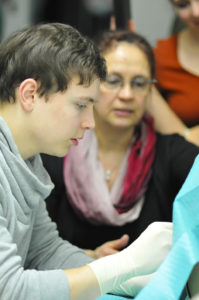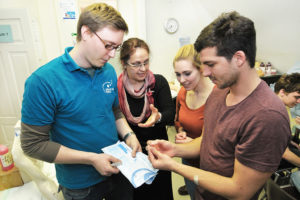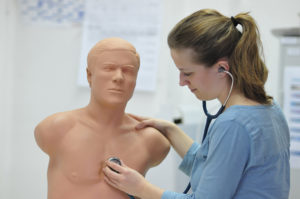Medical students practice at PERLE
Luca Frank carefully feels his way along the patient’s lumber spine. He locates a specific point with his index finger. ‘Here?’ the medical student asks, looking up. ‘Yes, try there,’ Dr. Anita Schmidt encourages him. The doctor sits next to Luca and watches him carry out his first lumbar puncture. In this procedure, which can be used to diagnose multiple sclerosis or meningitis, cerebrospinal fluid is taken from the lumbar spine.

‘It feels strange; there’s resistance here,’ says Luca as he tries to push a flexible, roughly ten-centimetre-long needle into the patient’s vertebral canal. ‘It should be easier than that,’ says Dr. Schmidt, surprised, and corrects the positioning of the needle. Several minutes later, his lips pressed tightly together, Luca pulls the needle back out – it is rather bent. And the patient? Luckily it is just a model made of rubber and plastic.
To ensure that Luca can place the needle properly the first time he carries out the procedure for real, he comes to the skills lab PERLE on Wednesday evenings to practice. PERLE, the medical training centre located at Kochstraße 19, stands for ‘PRaxis ERfahren und LErnen’ (experience and learn through practice). ‘Nothing has such a strong effect on learning as doing things yourself or showing others how to do them,’ explains Anita Schmidt, who also teaches at Staatliche Berufsfachschule für Krankenpflege, the vocational school for nursing at Universitätsklinikum Erlangen. She runs the training centre at FAU’s Faculty of Medicine together with Dr. Georg Breuer (Oberarzt), a doctor at Universitätsklinikum Erlangen’s Department of Anaesthesiology (head of department: Prof. Dr. Dr. h. c. Jürgen Schüttler).
PERLE was set up in 2005. The concept is that Anita Schmidt, Georg Breuer and other practising specialists teach medical students practical skills and train them to become tutors. The students then pass on their knowledge to their fellow students. Various studies have shown that this form of peer teaching is successful. ‘First of all, students are more likely to ask their fellow students for help than a trained doctor – they have less inhibitions in this situation. Additionally, in everyday clinical practice there are unlimited different ways of doing a certain thing correctly, such as filling a syringe. However, at PERLE we teach standardised processes that are always the same – on a very high level,’ explains Dr. Breuer.
PERLE does so well because of its tutors, their commitment and their ideas. They are the ones who design courses, create training documents and teaching videos, and go to symposiums to receive new input. Students in their fifth semester can become tutors and there are currently more than 20 of them. Most of them continue being tutors until the end of their studies. At the skills lab there are students responsible for materials and others who know exactly how to put the models of the body together. The training centre has around 30 different models: arms for placing peripheral venous catheters or drawing blood, model torsos that can be listened to and punctured, an anatomical skeleton with the bones labelled, and models of the head and abdomen.
Mistakes don’t hurt

‘What’s the right sort of compress for a central venous catheter? Can I use this one?’ Julian Baumann, a PERLE tutor in his ninth semester, passes Georg Breuer a piece of gauze in sterile packaging. The anaesthetist opens the plastic covering. ‘Look at the material – there mustn’t be any fluff,’ the experienced doctor explains. Julian now injects medication via a plastic connecting piece – known as a three-way valve – and a cannula in the jugular vein of the torso model.
‘The first eight semesters studying medicine is just about solid theory – but most of us want more practice,’ the student says. For this reason the demand for the mostly optional PERLE courses is high. There are 60 to 70 courses on offer each semester and during the week the centre is often open until past 9 p.m. The PERLE tutors teach over 900 students each year, giving courses on orthopaedics, microsurgery and suturing in preparation for placements or a practical year.
There are no silly questions when students are practising – and mistakes are allowed too. ‘From an ethical point of view, our skills lab is necessary. What we do here doesn’t hurt patients and has been proven to lead to better performance on patients later and to less complications – as well as shorter surgery times,’ explains Dr. Breuer. He strongly believes that the PERLE courses should be compulsory for all medical students. There is currently only one compulsory course – the introduction to clinical medicine in the fourth semester. In these 30-minute courses students use models to practice digital rectal examinations, drawing blood from veins, breast examinations and drawing blood from central venous catheters.
From models to patients

As part of a collaboration with the Institute of Anatomy trainee doctors can practice thoracic drainage – draining liquid or air from inside the chest area – on real body donors. In the future the tutors also hope to provide courses with actors as patients, as trained actors are able to mimic the symptoms in a realistic way and give the trainees doctors feedback from a patient’s perspective. In a similar way, experts in medical ethics (Professorship of Medical Ethics) already teach students how to break bad news to patients with the help of professional actors.
On this Wednesday evening, as the practising at PERLE draws to a close, it has already been dark outside for some time. Luca is pleased to have finally done his first lumbar puncture and recognised the difficulties of the procedure. Many other students also came to learn and teach at the skills lab today. ‘I’m proud of you,’ Georg Breuer says as he says goodbye to his tutors. Without them and their commitment PERLE would be nothing more than just a nice idea.
